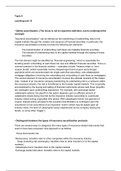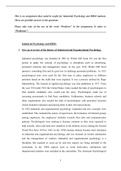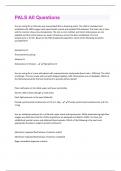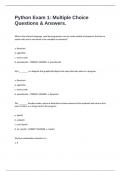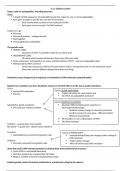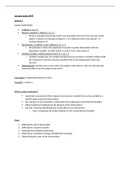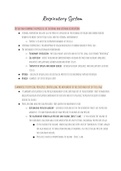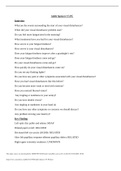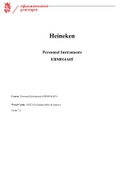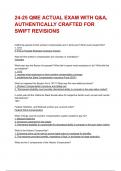Topic 6
Learning unit 12
• Define securitisation. (The focus is not to repeat the definition, but to understand the
concept)
“Insurance securitization” can be defined as the transferring of underwriting risks to the
capital markets through the creation and issuance of financial securities. In particular, the
insurance securitization process involves the following two elements:
· The transformation of underwriting cash flows into tradable financial securities.
· The transfer of underwriting risks to the capital markets through the trading of those
securities.
The first element might be identified as “financial engineering,” which is essentially the
bundling and/or unbundling of cash flows into new and different financial securities. This is a
common practice in the financial markets -- examples include Treasury strips or “zero-
coupon bonds” (which essentially involve stripped-apart bond coupon and principal
payments which are reconstructed into single-cash-flow securities), and collateralized
mortgage obligations (involving the unbundling and re-bundling of cash flows on mortgages).
The second element of insurance securitization involves the ultimate recipient of the traded
risks. Instead of an insurance company transferring its underwriting risk to a reinsurer within
the insurance industry, the risk is transferred to the broader capital markets. This is typically
accomplished by the buying and selling of financial instruments whose cash flows (payoffs)
are contingent upon underwriting experience. For example, with exchange-traded
catastrophe options, the payoff on the option depends upon a sufficient amount of
catastrophe losses being incurred by the insurance industry (according to a particular
industry index) during a specified time period. With catastrophe bonds, the payment of
coupon interest and/or principal to the investors (bondholders) is contingent upon the
occurrence or non-occurrence of an insurance “event” (which may be based upon an
industry index, the level of catastrophe losses experienced by the company issuing the
bonds, or some other “trigger”).
• Distinguish between the types of insurance securitisation products.
There are several ways to categorize the many types of insurance-related instruments that
exist or have been proposed. One approach is as follows:
· Those that transfer risk
Reinsurance: transfers risks to other companies within the insurance industry
Swap (including risk exchanges): transfers risks to other insurers (or to the capital
markets)
Catastrophe bond: transfers risks to the capital markets
Exchange-traded derivative: transfers risks to the capital markets
Learning unit 12
• Define securitisation. (The focus is not to repeat the definition, but to understand the
concept)
“Insurance securitization” can be defined as the transferring of underwriting risks to the
capital markets through the creation and issuance of financial securities. In particular, the
insurance securitization process involves the following two elements:
· The transformation of underwriting cash flows into tradable financial securities.
· The transfer of underwriting risks to the capital markets through the trading of those
securities.
The first element might be identified as “financial engineering,” which is essentially the
bundling and/or unbundling of cash flows into new and different financial securities. This is a
common practice in the financial markets -- examples include Treasury strips or “zero-
coupon bonds” (which essentially involve stripped-apart bond coupon and principal
payments which are reconstructed into single-cash-flow securities), and collateralized
mortgage obligations (involving the unbundling and re-bundling of cash flows on mortgages).
The second element of insurance securitization involves the ultimate recipient of the traded
risks. Instead of an insurance company transferring its underwriting risk to a reinsurer within
the insurance industry, the risk is transferred to the broader capital markets. This is typically
accomplished by the buying and selling of financial instruments whose cash flows (payoffs)
are contingent upon underwriting experience. For example, with exchange-traded
catastrophe options, the payoff on the option depends upon a sufficient amount of
catastrophe losses being incurred by the insurance industry (according to a particular
industry index) during a specified time period. With catastrophe bonds, the payment of
coupon interest and/or principal to the investors (bondholders) is contingent upon the
occurrence or non-occurrence of an insurance “event” (which may be based upon an
industry index, the level of catastrophe losses experienced by the company issuing the
bonds, or some other “trigger”).
• Distinguish between the types of insurance securitisation products.
There are several ways to categorize the many types of insurance-related instruments that
exist or have been proposed. One approach is as follows:
· Those that transfer risk
Reinsurance: transfers risks to other companies within the insurance industry
Swap (including risk exchanges): transfers risks to other insurers (or to the capital
markets)
Catastrophe bond: transfers risks to the capital markets
Exchange-traded derivative: transfers risks to the capital markets

